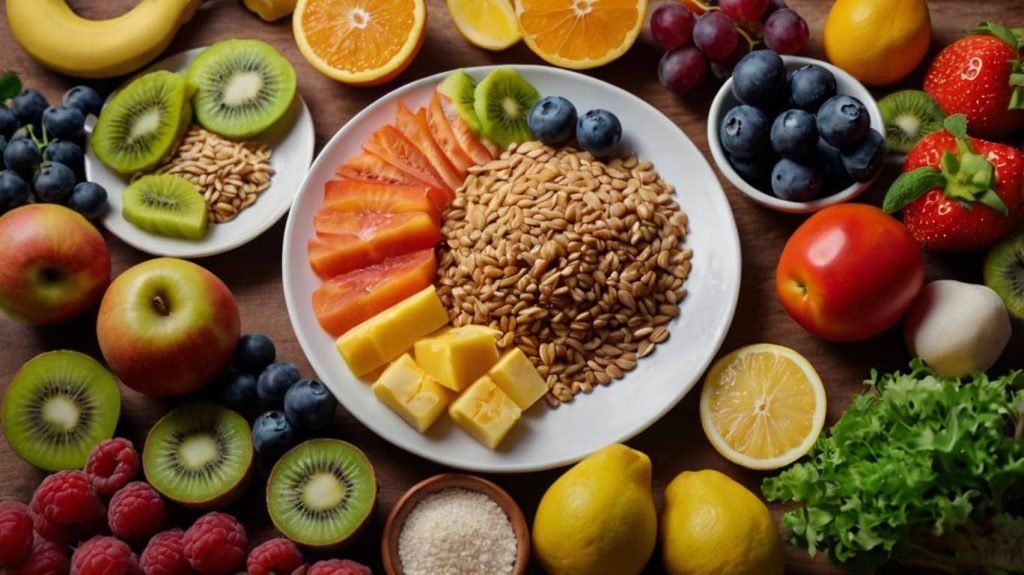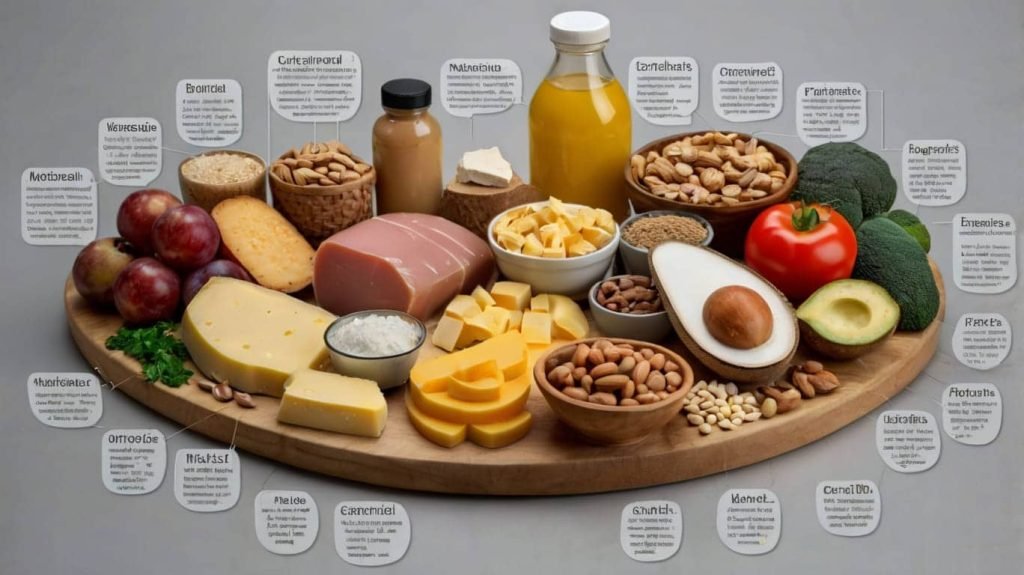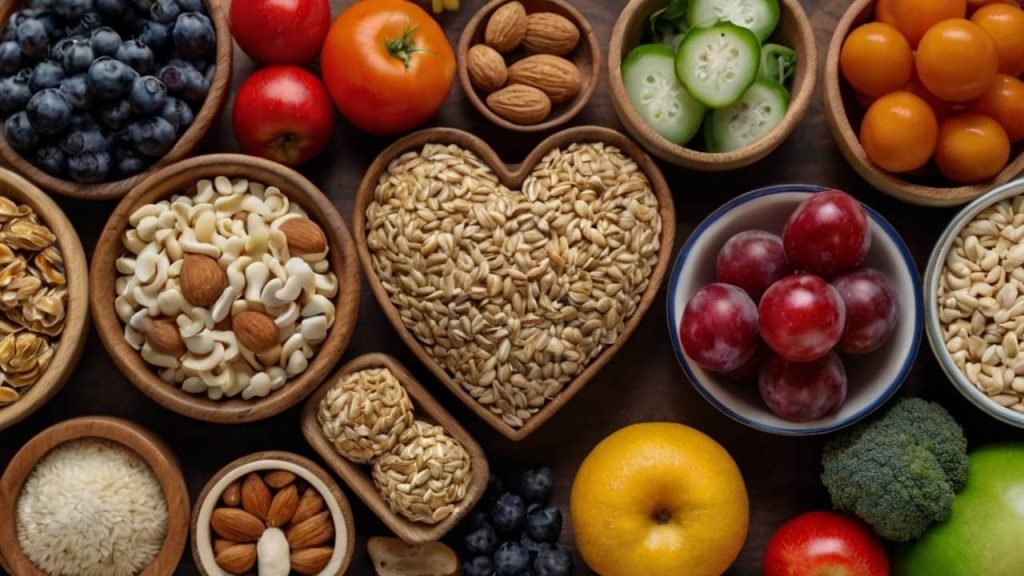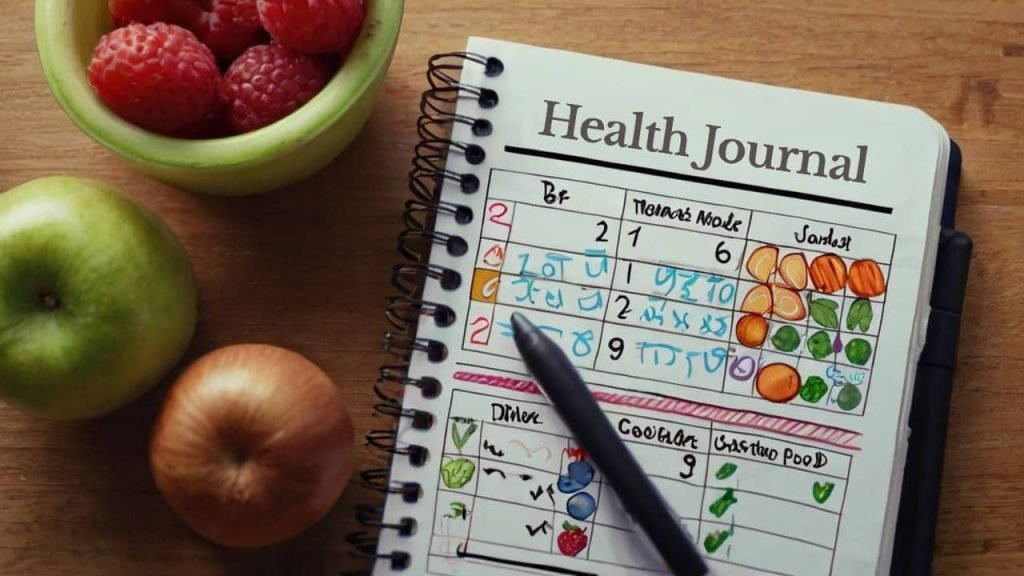Healthy eating isn’t just a fad or a trend—it’s a lifestyle choice that has the power to transform your life. From boosting energy levels to supporting mental health, eating well is foundational to living your best life. Whether you’re looking to manage weight, reduce the risk of chronic diseases, or simply feel your best every day, adopting healthy eating habits is key. This ultimate guide will walk you through the principles and practices of healthy eating, providing practical tips, insightful nutrition advice, and actionable steps to make balanced eating a part of your daily routine.
1. The Basics of Healthy Eating

Healthy eating begins with understanding the essentials—what makes a diet “healthy,” and why should we care? At its core, healthy eating revolves around a balanced diet that includes a variety of nutrients necessary for the body’s functions.
What is a Balanced Diet?
A balanced diet is one that provides your body with all the essential nutrients it needs to function properly. This includes macronutrients like carbohydrates, proteins, and fats, as well as micronutrients such as vitamins and minerals. But what does a balanced diet look like in practice?
- Variety is Key: Eating a wide range of foods ensures you get a broad spectrum of nutrients. Think of your plate as a canvas—fill it with different colors, textures, and flavors to create a balanced diet.
- Proportion Matters: Focus on getting the right proportions of macronutrients and micronutrients. A typical balanced diet consists of 50-60% carbohydrates, 20-30% fats, and 10-20% proteins.
- Moderation is Essential: It’s not about cutting out any food group entirely but consuming everything in moderation. Enjoy that slice of cake, but balance it with wholesome meals throughout the day.
The Benefits of a Healthy Diet
When we talk about healthy eating, we’re not just talking about weight loss or a lean physique. The benefits go far beyond that:
- Enhanced Physical Health: A diet rich in fruits, vegetables, whole grains, lean proteins, and healthy fats can lower the risk of chronic diseases such as heart disease, diabetes, and cancer.
- Improved Mental Well-being: Research has shown that nutrition plays a significant role in mental health. Foods rich in omega-3 fatty acids, like salmon and walnuts, can reduce symptoms of depression, while leafy greens may protect against cognitive decline.
- Sustained Energy Levels: A balanced diet that includes complex carbohydrates, fiber, and healthy fats will provide steady energy throughout the day, reducing those dreaded afternoon slumps.
2. Understanding Macronutrients and Micronutrients

Knowing what makes up your food and how it impacts your body is crucial to making informed choices. Let’s dive into the two major categories of nutrients: macronutrients and micronutrients.
The Role of Macronutrients in a Healthy Diet
Macronutrients are the nutrients your body needs in larger amounts. They provide energy and support overall health.
- Carbohydrates: Often misunderstood, carbohydrates are the body’s primary energy source. Focus on consuming complex carbohydrates like whole grains, fruits, and vegetables. These provide sustained energy and are packed with fiber, vitamins, and minerals.
- Proteins: Proteins are vital for muscle repair, immune function, and hormone production. Opt for lean sources like chicken, fish, beans, lentils, and tofu. Don’t shy away from plant-based proteins—they offer fiber and essential vitamins.
- Fats: Healthy fats, like those found in avocados, nuts, seeds, and olive oil, are essential for brain function, hormone production, and absorbing fat-soluble vitamins. Avoid trans fats and limit saturated fats.
Understanding Micronutrients in Diet
Micronutrients, although needed in smaller quantities, are equally vital for health.
- Vitamins: These organic compounds support immune function, energy production, and skin health. Vitamin D, for example, is crucial for bone health, while vitamin C boosts the immune system. Make sure to eat a variety of fruits and vegetables to cover your bases.
- Minerals: Calcium, magnesium, and iron are examples of essential minerals. They play a role in everything from bone health to oxygen transport in the blood. Include dairy products, leafy greens, and nuts in your diet for a well-rounded intake.
- Antioxidants: Though not technically a micronutrient, antioxidants are important. They fight off free radicals, reducing oxidative stress and preventing chronic diseases. Berries, nuts, and dark chocolate are great sources.
3. Practical Tips for Healthy Eating

Healthy eating isn’t just about knowing what’s good for you—it’s about putting that knowledge into practice. Here are some actionable tips to help you incorporate healthy eating into your daily life.
How to Create a Healthy Meal Plan
- Start with a Base of Vegetables: Vegetables should make up at least half of your plate. They are low in calories and high in nutrients. Think leafy greens, cruciferous vegetables like broccoli, and colorful peppers.
- Include a Source of Lean Protein: This could be chicken, tofu, fish, or beans. Aim for about a quarter of your plate to be protein.
- Choose Whole Grains: Opt for brown rice, quinoa, or whole wheat pasta over refined grains. Whole grains are packed with fiber and help keep you full longer.
- Add Healthy Fats: A sprinkle of nuts, a drizzle of olive oil, or some slices of avocado can enhance flavor and provide essential fatty acids.
Tips for a Nutritious Diet on a Budget
- Buy Seasonal Produce: Seasonal fruits and vegetables are not only fresher but also cheaper. They offer the best nutrition for their price.
- Purchase in Bulk: Items like whole grains, beans, nuts, and seeds are often cheaper when bought in bulk. They have a longer shelf life and can be incorporated into numerous recipes.
- Plan Your Meals: Planning helps you avoid impulse buys and reduces food waste. Create a weekly menu and stick to it.
Healthy Eating for Weight Management
- Focus on Nutrient Density: Choose foods that are high in nutrients but low in calories, like leafy greens, berries, and lean proteins.
- Practice Portion Control: Use smaller plates, measure portions, and listen to your body’s hunger cues. Mindful eating can prevent overeating.
- Stay Hydrated: Sometimes, thirst is mistaken for hunger. Drinking water throughout the day helps maintain metabolism and can reduce unnecessary snacking.
4. The Impact of Diet on Chronic Diseases

Food is more than fuel; it is medicine. Diet can have a profound impact on your risk of developing chronic diseases.
How Diet Impacts Chronic Diseases
- Heart Health: A diet high in saturated fats, trans fats, and cholesterol can lead to plaque build-up in the arteries, increasing the risk of heart disease. Conversely, a diet rich in whole grains, fruits, vegetables, and lean proteins can promote heart health.
- Diabetes: Refined carbohydrates and sugary foods can spike blood sugar levels, leading to insulin resistance over time. Healthy eating habits, such as choosing complex carbs and fiber-rich foods, help maintain blood sugar levels.
- Cancer Prevention: Certain foods contain compounds that may help protect against cancer. For example, cruciferous vegetables like broccoli contain sulforaphane, a compound believed to have cancer-fighting properties.
Best Foods for Heart Health
- Oats and Whole Grains: Rich in soluble fiber, which helps reduce LDL (bad) cholesterol.
- Fatty Fish: Salmon, mackerel, and sardines are rich in omega-3 fatty acids, which help reduce inflammation and lower blood pressure.
- Nuts and Seeds: Almonds, walnuts, and flaxseeds provide healthy fats, fiber, and antioxidants.
Science-Based Nutrition Advice
- Follow the Mediterranean Diet: Numerous studies have highlighted the benefits of the Mediterranean diet, which emphasizes fruits, vegetables, whole grains, and healthy fats.
- Limit Processed Foods: Processed foods are often high in sugar, salt, and unhealthy fats. Choose whole foods whenever possible.
- Stay Informed: Read up on nutrition from credible sources like Harvard Health and the World Health Organization.
5. Practical Tips for Everyday Healthy Eating

Healthy eating isn’t a sprint; it’s a marathon. It’s about creating habits that last.
Incorporating Healthy Foods into Your Meals
- Start Small: Swap refined grains for whole grains. Replace sugary snacks with fruits. Small changes add up over time.
- Cook at Home: Cooking meals at home allows you to control what goes into your food. Experiment with new recipes and make cooking a fun, engaging activity.
- Stay Hydrated: Water is often overlooked, but it plays a crucial role in digestion and nutrient absorption. Aim for at least 8 glasses a day.
Best Low-Calorie Healthy Snacks
- Greek Yogurt with Berries: High in protein and loaded with antioxidants.
- Hummus and Veggies: A fiber-rich, crunchy snack that satisfies.
- Apple Slices with Peanut Butter: Provides a mix of carbohydrates, protein, and healthy fats.
Understanding Nutrition Labels
- Look for Serving Sizes: Be mindful of serving sizes, as packaging can be misleading.
- Check for Hidden Sugars: Ingredients like fructose, corn syrup, and maltose are all forms of sugar.
- Focus on Fiber and Protein Content: Higher fiber and protein can help keep you full longer.
6. A Journey Towards Healthier Eating Habits

Changing your eating habits doesn’t happen overnight. It’s a gradual process that involves self-discovery and adaptation.
Tips for Staying Motivated
- Set Realistic Goals: Start with achievable targets. For example, aim to include a vegetable with every meal.
- Find a Support System: Join a community, involve your family, or find a friend with similar goals.
- Celebrate Your Progress: Reward yourself for sticking to your healthy eating plan. Remember, every small step counts.
How to Handle Eating Out
- Choose Wisely: Look for dishes that are grilled, baked, or steamed. Avoid fried and heavily sauced items.
- Portion Control: Don’t hesitate to ask for a half portion or pack half your meal to go.
- Stay Hydrated: Drink water before and during your meal to help control hunger.
7. Exploring Different Types of Healthy Diets

There isn’t a one-size-fits-all approach to healthy eating. Different diets work for different people, depending on their unique health needs, lifestyles, and personal preferences. Understanding the various types of diets can help you make an informed decision about what works best for you.
The Mediterranean Diet
The Mediterranean diet is consistently ranked as one of the healthiest diets worldwide. It emphasizes whole foods like fruits, vegetables, whole grains, lean proteins (especially fish), and healthy fats such as olive oil.
- Rich in Healthy Fats: The Mediterranean diet prioritizes monounsaturated fats found in olives, nuts, and seeds, which help reduce the risk of heart disease.
- Focus on Plant-Based Foods: Vegetables, fruits, legumes, and whole grains make up the majority of the diet, providing a rich source of fiber, vitamins, and minerals.
- Moderate Protein Intake: This diet favors fish and poultry over red meat, encouraging a moderate intake of protein with an emphasis on seafood.
The DASH Diet (Dietary Approaches to Stop Hypertension)
The DASH diet is designed to combat high blood pressure but also promotes overall health. It emphasizes foods rich in potassium, calcium, and magnesium, which are known to help lower blood pressure.
- Emphasis on Low-Sodium Foods: The DASH diet limits sodium intake to help control blood pressure levels. Fresh fruits, vegetables, whole grains, and lean proteins are staples.
- Encourages Whole Foods: The focus is on whole foods that are minimally processed, reducing the intake of added sugars and unhealthy fats.
- Flexible and Balanced: Unlike restrictive diets, the DASH diet is more flexible and sustainable, allowing for a wide variety of foods while promoting moderation.
The Flexitarian Diet
The Flexitarian diet is a flexible approach that combines the best of vegetarian eating with the occasional inclusion of meat or fish. It’s ideal for those who want to reduce their meat consumption without committing to a fully vegetarian or vegan lifestyle.
- Plant-Focused: The Flexitarian diet emphasizes plant-based foods like fruits, vegetables, legumes, nuts, and whole grains, with limited animal products.
- Reduces Processed Foods: It encourages limiting processed foods and refined sugars, promoting whole, nutrient-dense foods.
- Eco-Friendly: This diet is also more sustainable, as it encourages reducing meat consumption, which is beneficial for the environment.
8. Healthy Eating in Social Situations

Navigating social situations like family dinners, parties, and dining out can be challenging when trying to maintain a healthy diet. However, with a few smart strategies, you can enjoy these occasions without compromising your health goals.
Tips for Dining Out
- Review the Menu Ahead of Time: Most restaurants have their menus online, allowing you to plan your meal in advance. Look for options that include lean proteins, whole grains, and plenty of vegetables.
- Make Special Requests: Don’t hesitate to ask for modifications, like dressing on the side, grilled instead of fried, or substituting fries with a side salad.
- Practice Portion Control: Restaurant portions are often larger than what you need. Consider sharing a dish, asking for a half portion, or taking half of your meal home.
Managing Family Meals and Gatherings
- Offer to Bring a Healthy Dish: When attending a family gathering or potluck, offer to bring a nutritious dish that aligns with your dietary goals. This ensures there’s at least one healthy option available.
- Focus on Conversation, Not Just Food: Social events are about more than just eating. Engage in conversations, participate in activities, and shift your focus away from the food table.
- Eat Mindfully: Pay attention to your hunger cues and eat slowly. This helps you enjoy your food more and prevents overeating.
Staying on Track During Holidays
- Plan Ahead: Before holiday events, plan your meals for the day to accommodate indulgent meals. Opt for lighter meals leading up to a big dinner.
- Choose Your Treats Wisely: Decide which treats are worth indulging in and stick to those. Skip the ones you’re less enthusiastic about.
- Stay Active: Incorporate physical activity into your holiday plans. Go for a walk after dinner or play an outdoor game with family or friends.
9. Healthy Eating for Specific Health Conditions

Your diet can play a significant role in managing and preventing specific health conditions. Here’s how you can adapt your eating habits to address some common health concerns.
Healthy Eating for Heart Health
Heart disease is a leading cause of death worldwide, but diet plays a crucial role in prevention and management.
- Prioritize Omega-3 Fatty Acids: Omega-3s, found in fatty fish like salmon and flaxseeds, can help reduce inflammation and lower the risk of heart disease.
- Reduce Sodium and Sugar Intake: High sodium levels can increase blood pressure, while added sugars can lead to weight gain and increased heart disease risk. Limit processed foods and opt for natural sweeteners like honey in moderation.
- Incorporate Whole Grains and Fiber: Whole grains like oats, quinoa, and brown rice, along with fiber-rich foods like beans and vegetables, help reduce cholesterol levels and support heart health.
Nutrition Tips for Managing Diabetes
Managing diabetes involves maintaining stable blood sugar levels. Diet plays a central role in achieving this balance.
- Choose Low-Glycemic Index Foods: Foods like whole grains, legumes, and non-starchy vegetables have a lower glycemic index and don’t cause a rapid spike in blood sugar levels.
- Balance Carbohydrates with Protein and Fat: Pairing carbohydrates with protein or healthy fat can slow down the absorption of sugar and help maintain steady blood glucose levels.
- Stay Hydrated: Drinking plenty of water helps regulate blood sugar levels and keeps you hydrated without adding extra calories.
Adapting Your Diet for Digestive Health
Digestive issues like IBS, acid reflux, and bloating can often be managed with specific dietary changes.
- Increase Fiber Gradually: If you suffer from constipation or irregular bowel movements, gradually increasing your fiber intake can help. Start with small amounts and drink plenty of water.
- Limit Trigger Foods: Foods like spicy dishes, caffeine, and alcohol can trigger acid reflux or bloating. Pay attention to how your body reacts and adjust accordingly.
- Incorporate Probiotics and Prebiotics: Probiotics (found in yogurt, kefir, and fermented foods) and prebiotics (found in garlic, onions, and bananas) support a healthy gut microbiome.
10. The Role of Hydration in Healthy Eating

Hydration is often overlooked, but it is an essential component of healthy eating. Water supports digestion, nutrient absorption, and overall bodily functions.
How Much Water Do You Need?
- General Guidelines: While the “8 glasses a day” rule is a good starting point, hydration needs vary based on factors like age, gender, activity level, and climate. A more personalized approach is to drink half your body weight in ounces daily.
- Listen to Your Body: Thirst is a sign that your body needs water. Pay attention to cues like dry mouth, headaches, and fatigue, which may indicate dehydration.
- Hydrate Before Meals: Drinking a glass of water before meals can help with digestion and control hunger, potentially reducing calorie intake.
Hydrating Foods to Include in Your Diet
- Water-Rich Fruits and Vegetables: Cucumbers, watermelon, oranges, and strawberries are high in water content, making them great additions to your meals or snacks.
- Herbal Teas and Broths: Herbal teas and low-sodium broths can contribute to your daily fluid intake while providing additional nutrients.
- Avoid Dehydrating Beverages: Limit intake of caffeinated and alcoholic beverages, as they can increase fluid loss and contribute to dehydration.
Hydration Tips for Active Lifestyles
- Drink Water Before, During, and After Exercise: Stay hydrated by drinking water before you start exercising, sipping throughout your workout, and rehydrating afterward.
- Use Electrolyte Drinks When Needed: For prolonged or intense exercise, consider using electrolyte drinks to replenish lost salts and minerals.
- Carry a Reusable Water Bottle: Make it a habit to carry a water bottle wherever you go. This encourages regular hydration throughout the day.
11. Using Technology to Support Healthy Eating

In the digital age, technology can be a powerful ally in maintaining healthy eating habits. From apps to gadgets, here’s how tech can help you stay on track.
Nutrition and Meal Planning Apps
- Apps for Tracking Nutrients: Use apps like MyFitnessPal or Cronometer to track your daily intake of calories, macronutrients, and micronutrients. These apps can provide insights into your eating patterns and help you make healthier choices.
- Meal Planning Tools: Tools like Mealime or Yummly offer meal planning features that cater to your dietary preferences, helping you plan nutritious meals ahead of time.
- Mindful Eating Apps: Apps like Eat Right Now or Mindful Eating Coach help you develop mindful eating habits by offering guidance on portion control, hunger cues, and emotional eating.
Smart Kitchen Gadgets
- Smart Scales and Measuring Tools: Devices like digital food scales or portion control plates help you measure and track what you eat more accurately.
- Blenders and Juicers: High-quality blenders and juicers make it easier to incorporate fruits, vegetables, and other whole foods into your diet, encouraging healthier eating.
- Instant Pots and Slow Cookers: These appliances can simplify meal preparation, allowing you to make healthy, home-cooked meals with minimal effort.
Online Communities and Support
- Join Nutrition Forums and Groups: Engaging with online communities like Reddit’s r/nutrition or Facebook groups dedicated to healthy eating can provide support, inspiration, and advice from like-minded individuals.
- Follow Nutrition Experts: Subscribe to newsletters, blogs, and YouTube channels of nutrition experts for ongoing education and motivation.
- Use Social Media Wisely: Follow accounts that promote healthy living and positive body image. This can keep your feed filled with inspiring content that aligns with your health goals.
12. Ready to Take the Next Step? Keep Exploring for a Healthier Life!
Embarking on a journey toward healthy eating is an empowering choice that opens the door to a healthier, more fulfilling life. Remember, every small step you take adds up to significant improvements in your well-being. Want to learn more? Explore our other comprehensive guides on nutrition, meal planning, and wellness tips at NutriFlavorGuide.


